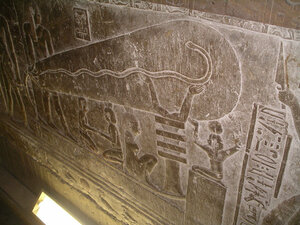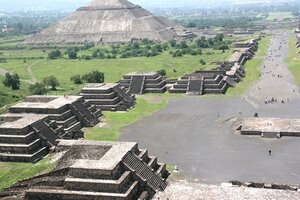-
Posts
904 -
Joined
-
Last visited
Content Type
Profiles
Forums
Gallery
Downloads
Blogs
Events
Our Shop
Movies
Everything posted by turboplanner
-
Some more ancient technology and communication: [ATTACH]48001._xfImport[/ATTACH] This mural at Dendera in Egypt appears to have an electrical insulator theme and shows winged figures similar to those depicted on the Ark of the Covenant. Based on the age of this mural, these people area unlikely to have been depicted as "angels" [ATTACH]48002._xfImport[/ATTACH] This is one of the Dendera "lamps", resting on an "insulator" and with a "cable" coming from the end [ATTACH]48003._xfImport[/ATTACH] The egyptians had the skill to craft these eyes with multi-layered lenses. [ATTACH]48004._xfImport[/ATTACH] The Osireion, with walls twenty feet thick, which we saw previously is believed to be the oldest stone building in Egypt. It was not orientated to a direct cardinal point, but to the east of due north, just like the Way of the Dead in Teotihuacan, Mexico shown here
-
Well we were talking about stone; so stone blocks vs cast concrete wall panels would be a good comparison
-
Fred Rogers, Dean of Dept Engineering, Illinois Institute of Technology: http://archives.chicagotribune.com/1933/03/05/page/12/article/death-miracle-of-ark-explained-as-electricity
-
The problem in dating the pyramids is that only one piece of wood had been found in an intact pyramid, the Great Pyramid, and that piece of wood was lost, so we can't date them. The Egyptologists patter is that the Saqqara pyramids were the practice run will initial collapses, then a stepped pyramid, then a shallow angle at about the halfway point, then the real thing, which sounds good, but the Saqqara location and the dimensions and orientation had none of the sophistication of the real thing and the thinking lately is that these were later attempts to emulate the Giza pyramids. We do have a date for the Unas pyramid, which definitey was built after the Giza pyramids, and this is what it looks like. [ATTACH]47998._xfImport[/ATTACH] I'm inclinded to agree with this thinking, because among the Saqqara pyramid efforts is the "temple" of Serapeum, which the Egyptologists claim to be chambers for burying bulls. This "temple" consists of "crypts" tunnelled out of limestone bedrock. In each crypt is placed a 65 ton box with 35 ton top lid on each side of a corridor tunnelled out of the rock The granite boxes measure 3.96 metres x 2.3 metres x 3.35 metres At the end of the tunnell there is no room to manually slide the last boxes into position. The sides and stop of the box and bottom of the lid were checked by a toolmaker using a straightedge and flashlight, and found to be perfectly flat. In other words the quality in the "temple" was right up to the Giza standard. There is general consensus that the Egyptian civilization came into being virtually overnight; one minute they were hunter-gatherers, the next minute they had all these skills; the question is which civilization came along, showed them what to do, then left. The Ark of the Covenant is another enigma, which as we know Moses took, or was given for his trip out of Egypt. The Egyptians in his time didn't seem to know what it was, or if they did, were not telling, but it burnt half his face off.
-
Well as we have seen above, we are talking about an error of 0.02% in 750 feet, not 10 mm per metre.
-
Well 1% is not a fraction of 1%, but yes, poorly worded: "The Flinders Petrie surveyed dimensions, when more of the pyramid was intact showed an 8 inch variation between the longest side and the shortest side, which is a variation of a fraction of 1%, something you don't find in buildings today." The actual fraction is available, it's 0.02% in 750 feet ("The Great Pyramid" John Romer P61. - it's a 564 page book with a massive amount of detail) If that doesn't knock your socks off: The mean corner angle error is 12 seconds of arc In setting the pryamid to true north, the builders found they had made an error with the stone construction, so re-orientated it by cutting the limestone casing stones to finish up with an error of only 5 seconds of arc from True North. The relationship of the base perimeter to the height of the pyramid is 2Pi, and thge measurements include the golden section and the Fibonacci series. A huge block of fine white limestone which stands at the top of the Grand Gallery has been set precisely at the point on the pyramid's vertical axis where the area of the base of the pyramid above the block is exactly half the area of the base of the pyramid. The block is also linked precisely to the main axis of the pyramid, and thus, through the four cardinal points to the stars of the night sky (but we won't go near God tonight).
-
Better idea than destroying the paintings for sure.
-
Watch the news over the next 12 months or so, one group believes, because of his sudden death, that he was buried in one of the entrance rooms of his mothers tomb two independent tests have indicated there's a cavity behind one of the walls of Tut's tomb. The problem is that on that wall are priceless paintings, so all involved are trying to come up with a method of getting into the sealed of tomb, which will make Tut's look like a street stall. No one is going to be putting so much as a Ryobi drill to to the wall unless there's a fail-proof solution, and that in itself is great news following the political demis of Zawi Hawass in the political upheaval. Hawass protected the monuments like a hawk.
-
I've never seen a list of the contents, figured they were all gone so no point looking. If the Catholics wanted to burn them that tells you something. The lighthouse was one of the eight wonders of the world though, fry your eyeballs.
-
The "pyramids for tombs" era is almost over, except for the Egyptologists. You can go on line and see photos of the Great Pyramid's Grand Gallery with its tapers and grooves and specialised structures at the top and see there's an engineering use. There has been an explosion or backfire of some sort in the King's chamber which has displaced the walls neatly outwards, chemical stains, anda Japanese research party found piston type wear on the grand gallery grooves, but no one's figured it all out yet. The library of Alexandria, which held most of the history of the world might have provided some answers, but the Christians burnt it to the ground.
-
Quite a large percentage of the population today wants everything summed up in a 30 second statement; that's not going to happen when you get involved in the history of a complete civilisation. So what? Well I get a kick out of drawing up a product to roughly meet the design requirement, then doing the small amount of work to get the lengths and widths and radii in harmony to make it not only functional, but great looking - and that came straiight from Egyptian skills. And when I'm trading I know not to buy into a Fibonacci level, and to use a sell target just before one, and those numbers don't belong to the Italian Fibonacci at all, but the Egyptians. And on the farm in setting up a fence at 90 degrees I just measure 30 metres, 40 metres and 50 metres........which came from the Egyptians. It's not until you get interested in their knowledge that you realise what an impact they had on our way of life.
-
The Flinders Petrie surveyed dimensions, when more of the pyramid was intact showed an 8 inch variation between the longest side and the shortest side, which is a variation of a fraction of 1%, something you don't find in buildings today. The corner angles are even more precise, but the geographic placement of the pyramid is stunning. What was at first to be an error from the round number was actually precisely correct when parallax was factored in. I just checked the link you provided and this was the comparison. The current team checked several points and then used software to estimate the lengths SIDE FLINDERS PETRIE DASH-LEHNER West 755.7629' 755.833 < 756.024' East 755.8745' 755.561 < 755.817 What is very interesting here is that Mark Lehner is an Egyptologist and the egyptologists fought the early researchers of about 20 years ago, disputing every discovery, but this has settled down to some reasonable research. I note that he is still attributing the Greater Pyramid to Khufu and the age to 4500 years, when the only link with Khufu and the age is a single cartouche of very suspicious history, which appears to have been debunked in the last couple of years by a family claiming a witness saw Vise paint it on (to keep the money flowing). What they didn't mention is that the stone blocks are arranged on each side in an almost imperceptible concave 'V" so that when you look at the pyramid from a distance, the side look flat, rather than slightly bulged.
-
We're using those to render our buildings?
-
It's believed to have been recharged from a larger size, and the head may have been recarved politically because it's out of proportion for a sphinx. It is perfectly aligned to face due east, the beginning of life (vs due west, death). Robert Shocht studied the weathering on the Sphinx and pit which show vertical rain erosion, indicating it is the oldest structure in Egypt, dating it to the end of the last ice age, around 6,000 years ago. The Cairo museum had got to an appallingly bad state before the international community stepped in and started to protect the museum and monuments. Not sure what's going on in today's troubled times. Most of what Von Daniken said was debunked almost immediately in "crash go the chariots" but that set lot's of people searching for the truth. It's clear that the Egyptians obtained their skills "overnight" in terms of the world's time scale, and lost them just as fast. They worked to an accuracy we can't achieve today, e.g. The polished limestone which once covered the pyramids described as polished to an optician's accuracy on a scale of acres.
-
Try under arm deodorant.
-
You'd probably be able to find out the situation by studying the history of Khartoum, which was at the confluence of the White and Blue Niles.
-
The Egyptians had trade routes right down into Ethiopia, and they had gauges along the Nile and were able to forecast the grain crop and build extra granaries when needed. They only had one God. In their written history of Kep Tepi, the first time, it explained how those beings (which we now call souls) wanted to experience human life, and tried throwing themselves into human bodies for a while. God warned them that this absorbed tremendous power and things could go wrong. Some of them found they could not get out of the body, others finished up with half human/ half animal, and some had major organs missing. These last were referred to as "things" and we're used as slaves. The successful conversions we're humans with a much advanced level of knowledge and skills. Since everyone knew what had happened, these people were not cobsidered gods, but acted as "champions" in teaching the population advanced skills.
-
Abu Simbell was the area covered by the dam. The Egyptologists thought it was a temple, but it's now thought to have some hydrographic use.
-
....and we're back to the Christian stories again, like being bogged in treacle. There were advanced civilisations with their own skills and beliefs well before this, for example: It's only 2000 years back to the days of Jesus Christ, but go back another 1400 years when Hapshepsut reigned - a female Pharaoh - diversity way back then! The priests held the scientific and engineering knowledge, and her temple is an example of the architectural proportioning that we still use today. They believed in a God, and wrote on papyrus. [ATTACH]47996._xfImport[/ATTACH] or go back 4,000 years before Christ to the Osirion at Abydos in Egypt; no stick cponstruction here, and the cyclopean architecture incoporates the orecise keying of huge blocks of stone found in Central America. and this was thouands of years before Kep Tepi, where Souls were discussed. [ATTACH]47997._xfImport[/ATTACH] Over these thousands of years before Christ, the people didn't get their knowledge from paid BS artists.
-
Yes, when they were hundreds of km from islands they read the swell, in the day time and had a very simple way of reading the stars at night. Then they looked for different species of land based sea birds which ranged out at different distances, and then they could use the convection clouds, but also they could do it at night.
-
I'm talking about historic facts, not fairy stories; fairy stories are fairy stories...but you knew that.
-
An anthropologist might study them when researching the origins of western civilisation. That certainly happens, but part of our criminal justice system is based on independent witness statements which corroborate an observation. In a case where a Sumerian text reports that something happened at dawn on the first day of spring in the tenth year after 'X" died, and a Qumram text says the same, and the bible says the same, that's pretty good evidence that it happened at 4:30 am on March 1, 145 BC. Well that descended into dribble didn't it. Many tribal stories have been proved to be accurate, and an example, which directly relates to us, is given in the book "We, the Navigators" which describes how Pacific Ocean tribes passed down navgation skill from generation to generation, which allowed them to sail hundreds of kilometres across the ocean and navigate back, not just to their home island, but to the break in the reef surrounding their home island.
-
It might be helpful for those making these one line quotes to understand that the Essenes were studying all of the various religions, as well as day to day life. Look at the dead sea scrolls as valuable research notes. Where they are of most value is in corroborating events in the Bible and Sumerian texts to provide corroborated dates and even times of some events.
-
Sacrificing animals, temples? Have you read any of the translations?






